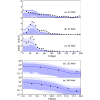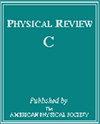Uncertainty quantification in (p,n) reactions
IF 3.4
2区 物理与天体物理
Q1 Physics and Astronomy
引用次数: 0
Abstract
Charge-exchange reactions are versatile probes for nuclear structure. In particular, when populating isobaric analog states, these reactions are used to study isovector nuclear densities and neutron skins. The quality of the information extracted from charge-exchange data depends on the accuracy of the reaction models and their inputs; this work addresses these two points. First, we quantify the uncertainties due to effective nucleon-nucleus interactions by propagating the parameter posterior distributions of the recent global optical model KDUQ [C. D. Pruitt, J. E. Escher, and R. Rahman, Phys. Rev. C 107, 014602 (2023)] to reaction observables populating the isobaric analog state, at beam energies in the range of 25–160 MeV. Our analysis, focusing on , shows that the total parametric uncertainties on the cross sections are around 60–100%. The source of this uncertainty is mainly the transition operator as the uncertainties from the distorted waves alone are less than about 15%. Second, we perform a comparison between two- and three-body models that both describe the dynamics of the reaction within the DWBA. The predictions from these two models are similar and generally agree with the available data, suggesting that one-step DWBA is sufficient to describe the reaction process. Only at a beam energy of 25 MeV are there possible signs that a one-step assumption is not fully correct. This work provides motivation for the quantification of uncertainties associated with the transition operator in three-body model. It also suggests that further constraint of the optical potential parameters is needed for increased model precision.

(p,n) 反应的不确定性量化
电荷交换反应是核结构的多功能探针。特别是在填充等压类似态时,这些反应可用于研究等向核密度和中子皮。从电荷交换数据中提取的信息的质量取决于反应模型及其输入的准确性;这项工作涉及这两点。首先,我们通过传播近期全球光学模型 KDUQ [C. D. Pruitt, J. E. Escher, and R. Rahman, Phys. Rev. C 107, 014602 (2023)]的参数后验分布,量化了有效核子-核相互作用引起的不确定性,并在 25-160 兆电子伏特的光束能量范围内,将(p,n)反应观测值填充到等压模拟态。我们以 Ca48 为重点进行的分析表明,横截面的总参数不确定性约为 60-100%。这种不确定性的来源主要是转换算子,因为仅来自扭曲波的不确定性就小于约 15%。其次,我们对描述 DWBA 内反应动力学的二体和三体模型进行了比较。这两种模型的预测结果相似,与现有数据基本吻合,表明一步 DWBA 足以描述反应过程。只有在束流能量为 25 MeV 时,才可能出现单步假设不完全正确的迹象。这项工作为量化与三体模型中转变算子相关的不确定性提供了动力。它还表明,要提高模型的精确度,还需要进一步限制光学势参数。
本文章由计算机程序翻译,如有差异,请以英文原文为准。
求助全文
约1分钟内获得全文
求助全文
来源期刊

Physical Review C
物理-物理:核物理
CiteScore
5.70
自引率
35.50%
发文量
0
审稿时长
1-2 weeks
期刊介绍:
Physical Review C (PRC) is a leading journal in theoretical and experimental nuclear physics, publishing more than two-thirds of the research literature in the field.
PRC covers experimental and theoretical results in all aspects of nuclear physics, including:
Nucleon-nucleon interaction, few-body systems
Nuclear structure
Nuclear reactions
Relativistic nuclear collisions
Hadronic physics and QCD
Electroweak interaction, symmetries
Nuclear astrophysics
 求助内容:
求助内容: 应助结果提醒方式:
应助结果提醒方式:


